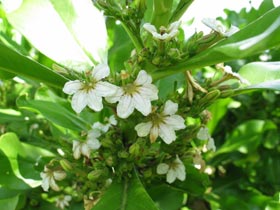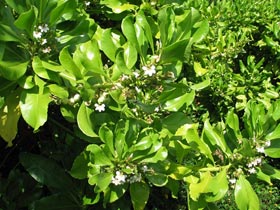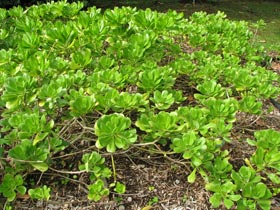Scaevola taccada
Genus
Scaevola
Species
taccada
Hawaiian Names with Diacritics
- Aupaka
- Huahekili
- Naupaka
- Naupaka kahakai
- Naupaka kai
Hawaiian Names
- Aupaka
- Huahekili
- Naupaka
- Naupaka kahakai
- Naupaka kai
Common Names
- Beach naupaka
- Naupaka
Synonyms
- Scaevola fauriei
- Scaevola frutescens
- Scaevola plumerioides
- Scaevola sericea
- Scaevola taccada var. sericea
Distribution Status
Indigenous
Endangered Species Status
No Status
Plant Form / Growth Habit
- Shrub
Mature Size, Height (in feet)
- Shrub, Dwarf, Less than 2
- Shrub, Small, 2 to 6
- Shrub, Medium, 6 to 10
Mature Size, Width
Naupaka kahakai grows to widths of 15 feet or more.
Life Span
Long lived (Greater than 5 years)
Landscape Uses
- Accent
- Container
- Erosion Control
- Ground Cover
- Hedges
- Provides Shade
- Screening
Additional Landscape Use Information
Naupaka kahakai is one of the most, if not the most, widely used of all native plants for commercial and residential landscapes in Hawaiʻi. They can be planted in practically every form of landscape, from beach parks, along roads and highways, commercial lots, and anywhere else requiring low maintenance and xeric needs. Plants can be used as an informal hedge, a tall filler to occupy "dead" space, as border planting, or as a windbreak against prevailing sea breeze. [11]
The "papa" or prostrate forms are used as a groundcover.
People often plant coastal naupaka kahakai on the makai side of the house and naupaka kuahiwi on the mauka side. [Rick Barboza, Hui Kū Maoli Ola]
Companion Plants:
Milo, kou, ʻohai (with papa forms), and naio.*
_____
* These plants can be found on this website using the "Browse Plants" feature found at the top. Enter names without diacritics.
Source of Fragrance
- Flowers
Plant Produces Flowers
Yes
Flower Type
Showy
Flower Colors
- Cream
- Greenish-White
- Purple
- White
- Yellow
Additional Flower Color Information
Naupaka kahakai in the Hawaiian Archipelago generally have pale yellowish-green to white cream-colored flowers with or without purple streaks. When combined with the white fruits, it makes for a nice display.
Blooming Period
- Year Round
Additional Blooming Period and Fruiting Information
Pulpy marble-sized round white fruits follow flowers. This is the only white-fruited naupaka (Scaevola spp.) native to the Hawaiian Islands.
Plant texture
- Fine
- Medium
- Coarse
Additional Plant Texture Information
Naupaka kahakai leaves are about 2 to 9 inches long and are oval-shaped with silky white hairs on the axil (between the leaf stem and a petiole or branch). The leaves are somewhat to moderately succulent.
Leaf Colors
- Light Green
- Medium Green
Additional Pest & Disease Information
These shrubs are prone to ants, as well as scale, spider mites and other sucking insects.
Fertilizer
Naupaka kahakai does not require much extra fertilizer, but will perform better with some periodic applications and foliar feeding throughout the year.
Pruning Information
Plants prune well, growing back thickly at cut branches and twigs. Best to hand prune. Hedgers, manual or power, slice leaves and stems giving them a "ragged" look and opening them up to a host of problems. Too, the overall appearance of naupaka kahakai looks much better when hand pruned.
Water Requirements
- Dry
Additional Water Information
Once established watering should be minimal. [11]
Soil must be well drained
Yes
Light Conditions
- Full sun
Additional Lighting Information
Naupaka kahakai is known to tolerate some shade, but produces lankier growth in that environment. Does best in full sun.
Tolerances
- Drought
- Wind
- Salt Spray
- Heat
Soils
- Clay
- Sand
- Cinder
- Organic
- Coral
Natural Range
- Niʻihau
- Kauaʻi
- Oʻahu
- Molokaʻi
- Lānaʻi
- Maui
- Kahoʻolawe
- Hawaiʻi
- Northwest Islands
Natural Zones (Elevation in feet, Rainfall in inches)
- Less than 150, 0 to 50 (Dry)
Additional Habitat Information
Naupaka kahakai is an indigenous shrub found throughout tropical and subtropical Pacific and Indian Ocean coasts. It is a common coastal shrub throughout the Hawaiian Archipelago, except on the higher rocky islands of Gardner Pinnacles (Pūhāhonu), Necker (Mokumanamana), and Nīhoa (Moku Manu).
![]() Special Features and Information
Special Features and Information
General Information
Scaevola belong to the Goodenia family or Goodeniaceae, of which there are over 130 species. There are ten native species of naupaka (Scaevola spp.). The featured species is the only indigenous naupaka, or scaevola, and the only one to produce white fruit in the Hawaiian Islands. The others are endemic and all produce dark purple fruits.
Etymology
The generic name Scaevola is derived from the Greek scaevus, left-handed or awkward, perhaps in reference to the "awkward" appearance of the "half flower" or to the signature flowers resembling an open fan or hand.
Since the specific epithets sericea and taccada seem to go back and forth in revisions, we have include the etymology for both.
The specific epithet sericea is derived from the Latin sericeus, silky or sikly-hairy, likely in reference to the short hairs found on the foliage of this plant. [7]
The specific epithet tacccada is [needed]
Hawaiian Names:
Aupaka is a Niʻihau name for this plant.
Huahekili means "hailstones." [8]
Naupaka kahakai means "naupaka by the seashore."
Background Information
The pulpy fruits tolerate salt water and float on the ocean currents for dispersal to other islands, unlike the dark purple fruits of the other native naupaka species which are eaten and dispersed by birds. However, the seeds of naupaka kahakai will only germinate with fresh water. [9]
The Legend:
In ancient times, one version goes, there was a beautiful Hawaiian princess known as Naupaka. One day, the villagers noticed that Naupaka looked very sad. They told her parents, who approached Naupaka and asked her what was troubling her.
“I have fallen in love with a man named Kaui,” replied the princess. “But Kaui is not of noble birth—he is a commoner.” According to Hawaiian tradition, it was strictly forbidden for members of royalty to marry people from the common ranks.
Distressed, Naupaka and Kaui traveled long and far, seeking a solution to their dilemma. They climbed up a mountain to see a kahuna who was staying at a heiau (temple). Alas, he had no clear answer for the young lovers. “There is nothing I can do,” he told them, “but you should pray. Pray at this heiau.”
So they did. And as they prayed, rain began to fall. Their hearts torn by sorrow, Naupaka and Kaui embraced for a final time. Then Naupaka took a flower from her ear and tore it in half, giving one half to Kaui. “The gods won’t allow us to be together,” she said. “You go live down by the water, while I will stay up here in the mountains.”
As the two lovers separated, the naupaka plants that grew nearby saw how sad they were. The very next day, they began to bloom in only half flowers.
There are different versions of the naupaka legend, but all carry the same unhappy theme: lovers that are separated forever, one banished to the mountains, the other to the beach. [10]
Early Hawaiian Use
Food:
The pithy fruits were eaten as refreshment on journeys or more or less in times of famine. [2,3]
Lei:
One older source (Charles Gaudichaud,1819) states that Hawaiians "used all fragrant plants, all flowers and even colored fruits" for lei making. The red or yellow were indicative of divine and chiefly rank; the purple flowers and fruit, or with fragrance, were associated with divinity. Because of their long-standing place in oral tradition, the flowers of naupaka kahakai were likely used for lei making by early Hawaiians, even though there are no written sources. [4]
Medicinal:
Mixed with salt, the fruit or root bark of naupaka kahakai was used for cuts, skin diseases [3,5,6] and wounds. [6]
Modern Use
Fabric dyes appearing from greenish-yellow to dark green have been made from with different mordants--a metalic substance for setting colors to the fabric. [1]
Both flowers and fruits are used today in lei. [4]
Local divers know to use the flowers, fruit or leaves to rub inside their diving mask instead of their saliva (hāʻae, spit) to prevent fogging.
Use Outside of the Hawaiian Islands:
Used medically elsewhere. The leaves can be cooked as greens. The wood is fashioned as pegs for boat building. [9]
In Malaysia, the pith is used for making "rice paper." [9]
Additional References
[1] "Hawaii Dye Plants and Dye Recipes" by Val Frieling Krohn-Ching, pages 111, 136.
[2] "Plants in Hawaiian Culture" by Beatrice H. Krauss, pages 17, 78, 103.
[3] "Native Planters in Old Hawaii--Their Life, Lore, & Environment" by E. S. Handy and Elizabeth Green Handy, pages 235, 238.
[4] "Nā Lei Makamae--The Treasured Lei" by Marie A. McDonald & Paul R. Weissich, pages XIV-XV, 98-99.
[5] "Hawaiian Herbs of Medicinal Value" by D.M. Kaaiakamanu & J.K. Akina, page 72.
[6] "Native Hawaiian Medicine--Volume III" by The Rev. Kaluna M. Kaʻaiakamanu, page 76.
[7] "The Names of Plants" by David Gledhill, page 350.
[8] "In Gardens of Hawaii" by Marie C. Neal, page 820.
[9] "Paradisus: Hawaiian Plant Watercolors" by Geraldine King Tam and David J. Mabberley, page 20.
[10] Aloha-Hawaii http://www.aloha-hawaii.com [Accessed 12/14/12]
[11] "How to Plant a Native Hawaiian Garden" by Kenneth M. Nagata, page "Naupaka kahakai."
PHOTOS FOR THIS SPECIES CAN BE SEEN AT THE LINK (Copy & Paste to your browser):
https://www.flickr.com/search/?user_id=50823119%40N08&sort=date-taken-desc&view_all=1&text=Scaevola%20taccada
Plant Gallery
Back to Plant List
Other Nursery Profiles for Scaevola taccada



